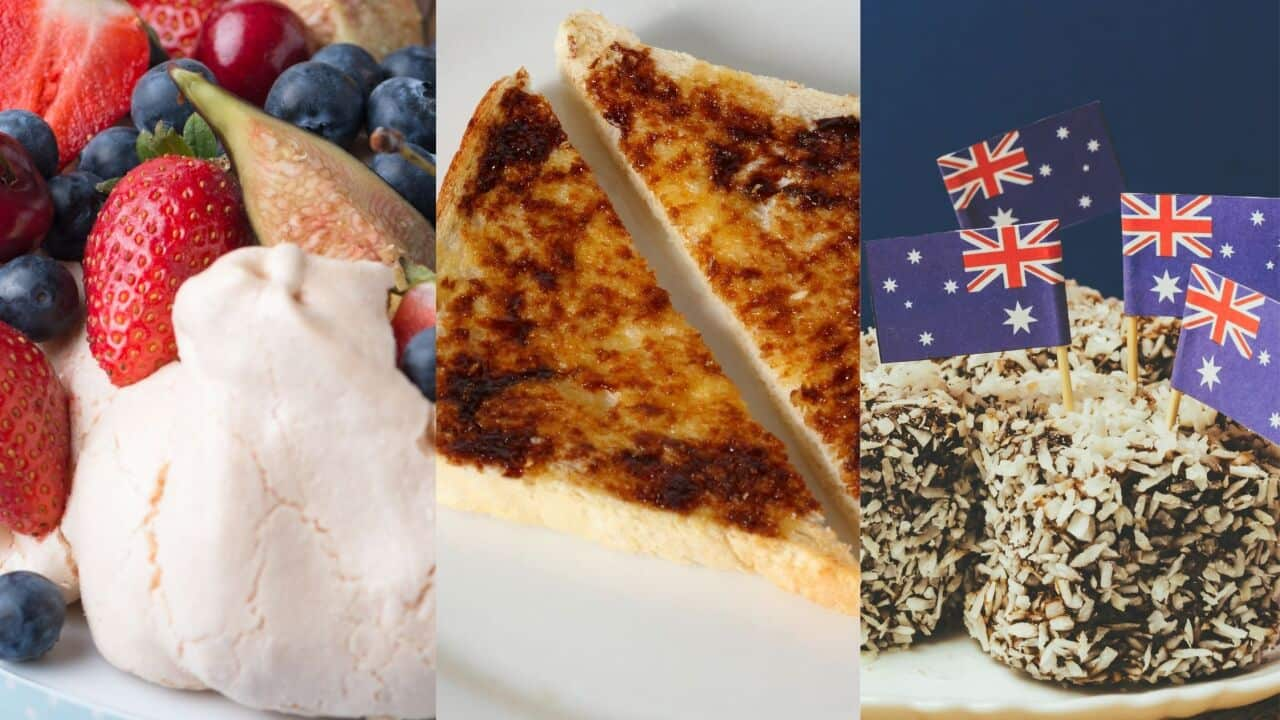Whether you are new to Australia or want to introduce visitors to Australian food, Australia has a lot of quirky options on offer.
In the second episode of the Australia Explained podcast we look at the most prominent and strangest Australian foods.
Listen to the Australia Explained on stories behind Australia's most iconic foods:
LISTEN TO

Australia Explained: Alamin ang kwento sa likod ng mga sikat na pagkain sa Australia
SBS Filipino
02/02/202229:52

Pavlova one of the most famous Australian desserts. Source:Flickr-lokate366CC BY-SA 2.0 Source: Flickr-lokate366CC BY-SA 2.0
Pavlova
One of the most famous Australian desserts during the summer and especially at Christmas is pavlova.
The history of pavlova in Australia is unclear. For Australians, it is a dessert designed in honour of the Russian ballerina Anna Pavlova, who visited the country from 1926 to 1929.
But Australia’s neighbour New Zealand says some of their cookbooks older than Pavlova's visit explain how pavlova is made. This dispute is considered one of the most famous cultural disputes between the two countries.

lamington cake Source: Getty Images
Lamington
Australians love lamingtons so much that there is a National Day dedicated to that delicious cake - July 21 every year. It is light and fluffy in the middle, dipped in chocolate on the outside, before being rolled in coconut.
The Australian recipe for lamington cake dates back over 100 years, and most believe it it named after Lord Lamington, the first governor of Queensland.

Vegemite is one of the main ingredients in an Australian breakfast. APP Image -AP Rod McGuirk Source: APP Image-AP Rod McGuirk
Vegemite is close to 100 years old as one of the most uniquely Australian foods.
It was originally designed to be like the famous British ‘Marmite’. Shipments of Marmite from Britain stopped after the end of World War Iso there was a gap in the market.
The Marmite recipe was not made public so after experiments in 1922, the result was Vegemite as we know it today, made from the barley waste after beer production. If you compare Vegemite and Marmite, you will find similarities but they’re not quite the same.
Vegemite became popular in World War II when the Australian government sent it with food rations for soldiers at war. It reminded soldiers of their homeland during their battles in various countries. By the end of the 1940sVegemite was in nine out of ten homes in Australia.

Cereals can be complex carbohydrates and some are full of nutritious whole grains. Source: Flickr
Weetbix
Weet-Bix was first produced in Sydney in the mid-1920s as a rival to a similar product from Sanitarium. As a cheap, healthy breakfast it became the country’s favourite breakfast food during the Great Depression in 1929. It was also a food for soldiers during World War II.

Tim Tam favourite chocolate biscuit in Australia. Source:Flickr Source: Source:Flickr
A name that needs no introduction, this is a bikky, that many Aussie citizens miss when overseas. Two pieces of chocolate biscuit, with chocolate cream in between, covered with more chocolate.
The recipe was developed in 1958 at Arnott’s Biscuit Company and was named by Ross Arnott, owner of the company. It is named after winning racehorse - Tim Tam.
They were first in stores in 1964 and became the most popular biscuit in the country. Many types have been designed, including double coated, caramel, mint and many more, as well as innovated ways to eat Tim Tams, like the Tim Tam Slam.

Kangaroo tail cook on a fire on Mutitjulu land in the Northern Territory on Wednesday, Feb. 10, 2010. Source - AAP Image - Paul Miller Source: Source - AAP Image - Paul Miller
This animal, which is associated in everyone's mind with Australia, is also a guest on (not at!) the Australian table. Kangaroo meat is one of the healthiest meats, being very lean. It tastes a lot like beef, but it has a higher protein and iron content.It also has fewer calories and is a good source of omega-3.

Witchetty Grub on hand. Source - Flickr - Doug Beckers Source: Source - Flickr - Doug Beckers
Native to Australia, the witchetty grub is most commonly found in remote areas.It was originally called ‘witjuri’ by the Adnyamathanha people of South Australia’s Central Desert. It’s a popular ingredient in Indigenous cooking, as the First Nations would search for it inthe roots of the Witchetty bush. This caterpillar is full of nutrients, making it a staple of the Indigenous diet for thousands of years.
However, when Europeans arrived in Australia, they did not include them in their diet and were not so popular within the colonies. But with the passage of time, witchetty grubs began gaining popularity among Australians. The grubs are beginning to appear on restaurant menus across the country.The taste is described as between chicken and prawns.

Pie eater's view of the footy Source: Flicker - Marc Ellis
Like the United States has the hamburger, Australia has meat pies. Almost no bakery is without them. In fact, Aussies eat 270 million pies a year!
It’s a cup of pastry that can rest in your hand, filled with meat, and topped pastry and cooked in the oven. When ready to eat, most people top it with tomato sauce. These savoury pies have become an Aussie icon, even though they didn’t originally come from here.
Pastries filled with minced meat can be traced back to the ancient Egyptian, Greek and Roman civilizations, but the pies that we know came from old British recipes as a way to preserve meat.
It arrived in Australia with the gold rush in the 1850s and remained popular ever since!
You can listen to all episodes of Australia Explained in Apple Podcasts, Google Podcasts and Spotify.
Australia Explained was originally created by Maram Ismail for SBS Arabic24.
